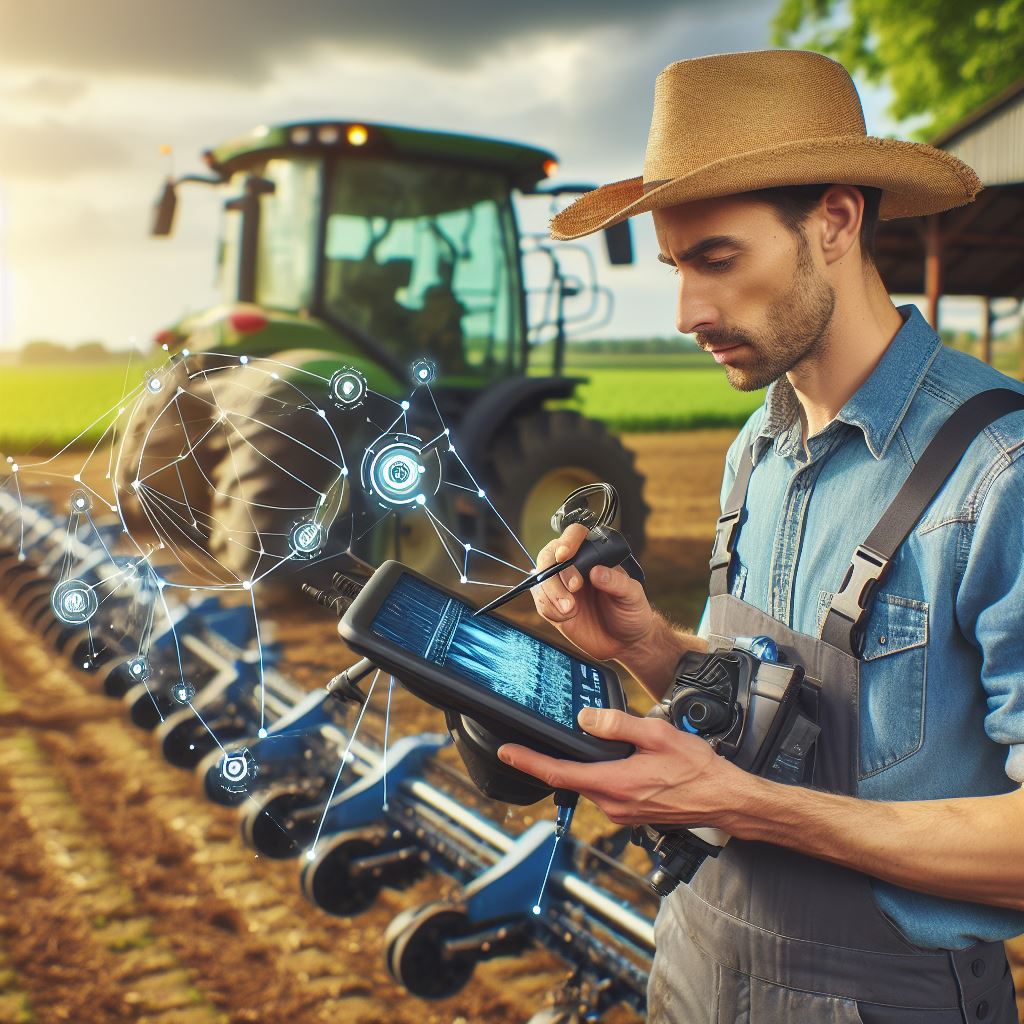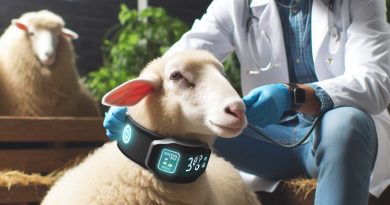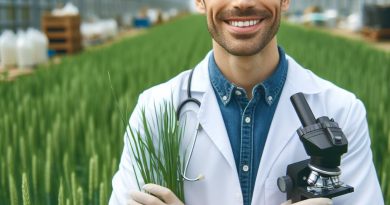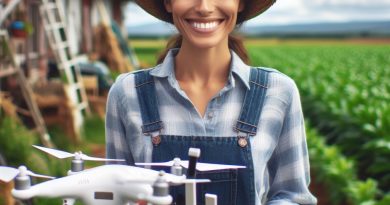Precision Agri: The Tech Revolution
Last Updated on March 2, 2024
Introduction
A. Definition of Precision Agriculture
Precision Agriculture, also known as smart farming or satellite farming, is a modern farming management concept that uses technology to improve efficiency and maximize crop yield.
It involves the use of various tools, such as GPS, sensors, robotics, and data analytics, to collect and analyze data about soil conditions, weather patterns, crop growth, and livestock health.
This data-driven approach enables farmers to make more informed decisions and take precise actions, resulting in reduced costs, increased productivity, and optimized resource utilization.
B. The Importance of Technology in Agriculture
Technology plays a crucial role in modern agriculture by revolutionizing traditional farming practices.
The adoption of innovative technologies has significantly transformed the agriculture sector, making it more efficient, sustainable, and productive.
Advanced machinery and equipment have automated various tasks, allowing farmers to accomplish them faster and with higher accuracy.
Additionally, the integration of digital platforms and connectivity has empowered farmers to access real-time information, collaborate with experts, and make informed decisions remotely.
By leveraging technology, farmers can optimize resource allocation, predict and mitigate risks, minimize environmental impacts, and meet the growing demands of a rapidly increasing global population.
In the next section, we will delve deeper into the specific technologies driving the precision agriculture revolution.
We will explore the benefits they offer, examine their challenges and limitations, and discuss their potential impact on the future of farming.
Join us in unraveling the fascinating world of precision agriculture and discover how technology is shaping the agricultural landscape like never before.
The History of Precision Agriculture
A. Early beginnings and the use of basic technology
- Farmers have always strived for efficiency and productivity in their agricultural practices.
- In the early days, basic tools like hand-held plows and simple irrigation systems were used.
- The introduction of mechanized farming equipment, such as tractors and combine harvesters, revolutionized agriculture.
- The development of early GPS technology in the 1980s provided a breakthrough for precision agriculture.
- Farmers started using GPS systems to map fields, monitor soil variability, and create accurate yield maps.
B. Advancements in technology and their impact on agriculture
- As technology continued to advance, precision agriculture saw significant improvements.
- The use of satellite imagery allowed farmers to assess crop health, detect pests and diseases, and optimize yields.
- Automated machinery, like robotic planters and harvesters, increased efficiency and reduced labor costs.
- Drones equipped with high-resolution cameras were introduced, enabling farmers to monitor crops from the sky.
- Sensor technology became more sophisticated, providing real-time data on soil moisture, temperature, and nutrient levels.
C. The emergence of Precision Agriculture as a concept
- The term “Precision Agriculture” was first coined in the early 1990s to describe the integration of technology in farming.
- Precision Agriculture aimed to maximize efficiency by using data-driven decision-making and targeted farming practices.
- The concept gained traction as farmers recognized the potential to optimize inputs, reduce waste, and increase profitability.
- Governments and agricultural organizations began promoting Precision Agriculture as a sustainable solution to feeding a growing population.
- Today, Precision Agriculture is a globally recognized industry, with farmers adopting advanced technologies worldwide.
- The focus is on optimizing resource allocation, reducing environmental impact, and enhancing overall farm management.
In essence, the history of Precision Agriculture traces back to the basic tools and techniques used by early farmers.
Over time, advancements in technology, such as GPS systems, satellite imagery, and sensor technology, revolutionized the industry.
Precision Agriculture emerged as a concept to optimize farming practices through data-driven decision-making.
Today, Precision Agriculture is an essential part of modern farming, enabling farmers to achieve higher yields, reduce waste, and contribute to sustainable agriculture.
Read: Precision Agriculture: How Drones Change the Game
Key Technologies in Precision Agriculture
Agriculture is undergoing a significant transformation with the advent of precision agriculture.
This tech revolution has brought forth various key technologies that are revolutionizing the way farming is done.
In this section, we will explore some of these key technologies and their impact on agriculture.
A. Global positioning systems (GPS) and satellite imagery
The integration of global positioning systems (GPS) and satellite imagery has been a game-changer in precision agriculture.
Farmers can now accurately locate their crops and monitor their growth using GPS technology.
Satellite imagery provides high-resolution images that enable farmers to identify variations in crop health and optimize their farming practices accordingly.
B. Remote sensing and drones
Remote sensing technologies, along with the use of drones, are another crucial aspect of precision agriculture.
Drones equipped with sensors and cameras can collect valuable data about crops, soil conditions, and irrigation needs.
This data, combined with remote sensing technologies, provides farmers with real-time information about their fields, leading to better decision-making and more efficient resource management.
C. Soil sensors and monitoring systems
Soil sensors and monitoring systems allow farmers to precisely monitor the moisture levels, nutrient content, and temperature of the soil.
These technologies help farmers determine the exact amount of water, fertilizers, and other inputs required for optimal crop growth.
By ensuring that crops receive the right amount of nutrients and water, farmers can minimize waste and maximize yield.
D. Data analytics and artificial intelligence
Data analytics and artificial intelligence (AI) play a crucial role in precision agriculture.
By analyzing the data collected from various sources such as sensors, drones, and satellites, AI algorithms can provide farmers with valuable insights and recommendations.
These insights can help farmers make data-driven decisions, optimize crop management strategies, and predict potential issues before they become major problems.
Precision agriculture, with the aid of these key technologies, has the potential to revolutionize the agricultural industry.
By using GPS and satellite imagery, farmers can improve crop monitoring and optimize resource allocation.
Remote sensing technologies and drones enable real-time data collection, leading to better crop management.
Soil sensors and monitoring systems provide precise information about soil conditions, ensuring optimal crop growth.
Finally, data analytics and AI help farmers make informed decisions and improve overall farm efficiency.
With the continuous advancements in technology, precision agriculture is likely to become even more sophisticated in the future.
Integration of these key technologies will enable farmers to further enhance productivity, reduce environmental impact, and ensure food security.
It is an exciting time for agriculture, as precision agriculture continues to pave the way for a more sustainable and efficient future.
Read: Agri Robots: Revolutionizing Precision Agriculture
Benefits and Advantages of Precision Agriculture
A. Increased efficiency and productivity
- Precision agriculture allows farmers to optimize their farming operations with the help of technology.
- By using sensors, drones, and GPS technology, farmers can gather data about their fields in real-time.
- This data helps them make informed decisions on irrigation, fertilization, and pest control.
- Farmers can apply the right amount of inputs to specific areas, minimizing waste and maximizing efficiency.
- With precision agriculture, farmers can monitor and manage their crops remotely, saving time and effort.
- Automated machinery and equipment enable farmers to complete tasks more quickly and accurately.
- All these factors result in increased productivity and higher crop yields.
B. Resource optimization and reduced environmental impact
- Precision agriculture helps conserve resources such as water, fertilizers, and pesticides.
- By applying inputs only where and when needed, farmers can minimize their usage and reduce waste.
- This optimized resource management leads to cost savings and reduces the environmental impact of farming.
- Farmers can prevent overuse of chemicals, minimizing water pollution and soil degradation.
- By using satellite imagery and weather data, farmers can schedule irrigation more efficiently.
- Precision agriculture promotes sustainable farming practices and promotes biodiversity in agricultural areas.
C. Improved crop quality and yields
- With precision agriculture, farmers can closely monitor the health and growth of their crops.
- Sensors and cameras can detect diseases, nutrient deficiencies, and other crop issues at an early stage.
- By identifying problems early, farmers can take swift action and prevent significant crop losses.
- Precision agriculture also enables precise application of fertilizers and nutrients, improving crop quality.
- Farmers can ensure uniformity in their fields, resulting in more consistent yields and better-quality produce.
- By monitoring environmental conditions, farmers can make adjustments to optimize crop growth and quality.
D. Cost savings for farmers
- Precision agriculture technology can help reduce input costs for farmers.
- By applying inputs based on data-driven decisions, farmers can avoid unnecessary expenses.
- Farmers can save on fertilizers, pesticides, and water by using them judiciously.
- Precision agriculture also reduces labor costs by automating tasks.
- With automated machinery and equipment, fewer workers are required for specific tasks.
- Farmers can also save on fuel costs by optimizing machinery routes and reducing overlapping operations.
- In the long run, precision agriculture offers cost savings and improves the profitability of farming.
Precision agriculture brings numerous benefits to farmers, the environment, and overall food production.
With increased efficiency, optimized resource management, improved crop quality, and cost savings, it is a transformative revolution in the agricultural industry.
By embracing precision agriculture, farmers can meet the challenges of feeding a growing population while minimizing the environmental impact of farming.
Read: AI in Farming: Precision Ag Revolution

Find Out More: Hydroponics & Aquaponics: Tech Insights
Uncover the Details: Big Data: Transforming Agriculture
Challenges and Adoption of Precision Agriculture
Precision agriculture presents numerous challenges that need to be addressed for widespread adoption and success.
However, despite these challenges, the benefits of precision agriculture outweigh the hurdles.
As technology continues to advance, the costs associated with precision agriculture are expected to decrease, making it more accessible to farmers.
A. High upfront costs and access to technology
To overcome the challenge of high upfront costs and limited technology access, governments and agricultural organizations can provide financial assistance and subsidies for farmers to invest in precision agriculture equipment.
Collaborations with technology companies can also help bring advanced technologies to remote areas.
B. Data management and privacy concerns
Data management and privacy concerns can be addressed through the implementation of strict data protection measures, including encrypted storage, secure data transfer protocols, and clear consent and privacy policies.
Governments can regulate the use and sharing of agricultural data to ensure privacy while promoting data-driven decision-making.
C. Training and education for farmers
To support farmers in acquiring the necessary training and education, agricultural extension services and organizations can offer workshops, training programs, and online resources.
These initiatives can help farmers develop the skills needed to effectively use precision agriculture technologies and understand the interpretation of data.
D. Government policies and regulations
Government policies and regulations should be formulated with the active participation of farmers, industry experts, and other stakeholders.
These policies should promote the adoption of precision agriculture while addressing environmental concerns and ensuring fair market practices.
Regulatory bodies can also play a role in monitoring and enforcing compliance with these policies.
In a nutshell, while challenges exist, the adoption of precision agriculture has the potential to revolutionize the farming industry.
High upfront costs, data management concerns, training needs, and government regulations can be overcome through collaborative efforts and strategic planning.
By embracing precision agriculture, farmers can increase productivity, reduce environmental impact, and improve the overall sustainability of agriculture.
Read: Precision Agri: GPS Guided Farming Explained
Learn More: Self-Driving Tractors: Farming Made Easy
Current Trends and Future Outlook
A. Integration of Internet of Things (IoT) and automation
The integration of IoT and automation in precision agriculture is a major trend that is shaping the industry.
By combining IoT sensors and devices with automation technologies, farmers are able to monitor and control various aspects of their operations.
This integration enables real-time data collection, analysis, and decision-making, ultimately leading to increased efficiency and productivity.
From soil moisture monitoring to automated irrigation systems, IoT and automation are revolutionizing precision agriculture.
B. AI-driven decision support systems
Artificial intelligence (AI) is being increasingly utilized in precision agriculture to develop decision support systems.
AI algorithms analyze vast amounts of data collected from sensors, satellites, and drones to provide farmers with actionable insights.
By predicting crop yield, disease outbreaks, and optimal harvesting times, AI-driven decision support systems help farmers make informed choices.
These systems enable farmers to optimize crop production, reduce resource wastage, and maximize profitability.
C. Use of precision agriculture in livestock farming and aquaculture
While precision agriculture is commonly associated with crop farming, its application is not limited to the field.
The principles and technologies of precision agriculture can also be applied to livestock farming and aquaculture.
Smart sensors and monitoring systems can track animal health, behavior, and nutrition, helping farmers optimize livestock productivity.
Similarly, in aquaculture, precision agriculture techniques can be used to monitor water quality, feed intake, and growth rates of fish.
D. Opportunities for innovation and startups in the industry
The rapid advancement of precision agriculture presents numerous opportunities for innovation and startups in the industry.
With the increasing demand for sustainable and efficient farming practices, entrepreneurs can develop new technologies and solutions.
Startups focusing on drone technology, AI-based analytics, precision irrigation systems, and data-driven farm management platforms are flourishing.
Investors are recognizing the potential of these innovations and are actively funding startups in the precision agriculture sector.
E. The future outlook of precision agriculture
The future outlook of precision agriculture is optimistic, with ongoing advancements in technology and increasing adoption by farmers.
Integration of IoT and automation will continue to streamline farming processes, leading to improved productivity and reduced environmental impact.
AI-driven decision support systems will become more sophisticated, providing farmers with highly accurate predictions and actionable recommendations.
The use of precision agriculture principles in livestock farming and aquaculture will contribute to sustainable and efficient animal production.
The industry will also witness a surge in innovation and new startups addressing the diverse challenges of modern agriculture.
Precision agriculture is ushering in a tech revolution that has the potential to transform the way we produce food.
With the world’s population projected to reach 9.7 billion by 2050, the need for sustainable and efficient farming practices is paramount.
By leveraging IoT, automation, AI, and precision techniques, farmers can meet the growing demand for food while minimizing environmental impact.
As the industry continues to evolve, precision agriculture will play a pivotal role in shaping the future of farming.
Uncover the Details: Harvest Tech: Robotic Arms in Use
Conclusion
A. Recap of key points
Precision Agriculture revolutionizes the farming industry by utilizing technology to enhance productivity and sustainability.
Key points discussed in this blog post include:
- The use of drones, GPS, and sensors for data collection and analysis;
- The benefits of Precision Agriculture in optimizing inputs and reducing waste;
- The potential for increased profitability and environmental conservation;
- The importance of adapting to changing agricultural trends and consumer demands;
- The role of Precision Agriculture in addressing global challenges, such as food security and climate change.
B. The significance of Precision Agriculture in transforming the industry
Precision Agriculture is not just a trend but a paradigm shift that holds great significance in the future of farming.
Embracing technological advancements and incorporating them into daily practices will lead to improved efficiency, accuracy, and sustainability in agricultural operations.
C. Encouragement for farmers to embrace technological advancements in agriculture
To fully leverage the potential of Precision Agriculture, it is crucial for farmers to be open-minded and willing to embrace these technological advancements.
Investing in training and education, establishing collaborations with technology providers, and staying up-to-date with industry developments will be instrumental in maximizing the benefits of Precision Agriculture.
As Precision Agriculture continues to expand its reach, it has the power to revolutionize farming practices and contribute to a more sustainable and food-secure future.
By harnessing the power of technology, farmers can lead the way in shaping a more efficient and environmentally conscious agricultural industry.


